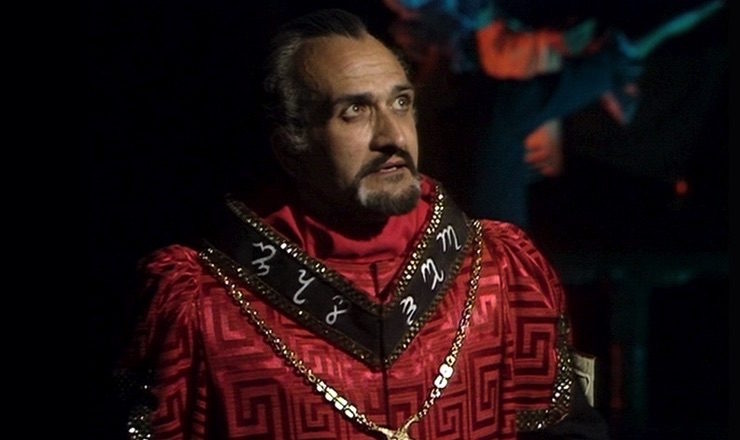About a week ago, the BBC were forced to confirm that John Simm would be returning to Doctor Who to play The Master alongside Michelle Gomez’s Missy. While the manner of this spoiler damage control was colossally annoying, it’s led to a lot of fun speculation about just how well the two incarnations will work together. A lot of people are expecting a Master vs. Missy showdown, but, given the clear throughline of the character over the course of the show’s history, I think they’re going to get on like someone else’s house on fire.
Roger Delgado was the first actor in the role, appearing for the first time in “Terror of the Autons.” The character was set up, almost straight away, as a dark mirror of the Doctor. What made him especially interesting was how that gave context to the often mercurial, difficult-to-like Third Doctor. Where he was impulsive and at times dismissive, Delgado’s Master was calm, patient, and even likeable, in a way that made the Third Doctor’s emotional growth all the more powerful and, in turn, the Master’s lack of it all the more telling.
Delgado, tragically, was killed in a car accident in 1973 and the role was relegated to limbo while the show tried to work out where to go with it. Peter Pratt and Geoffrey Beevers both played the Master after Delgado but each time appeared under heavy makeup and gore—this Master was at the end of his final regeneration and desperate for more life. That led to his turn in “The Keeper of Traken,” in which the character transferred his life force into an innocent scientist named Tremas. That in turn led to him forcing the Doctor’s regeneration into his fifth incarnation, with the added emotional baggage of Tremas being the father of the Fifth Doctor’s companion, Nyssa. With a new Doctor, played by Peter Davison, and a new Master, played by Anthony Ainley, the show moved definitively into a new era.
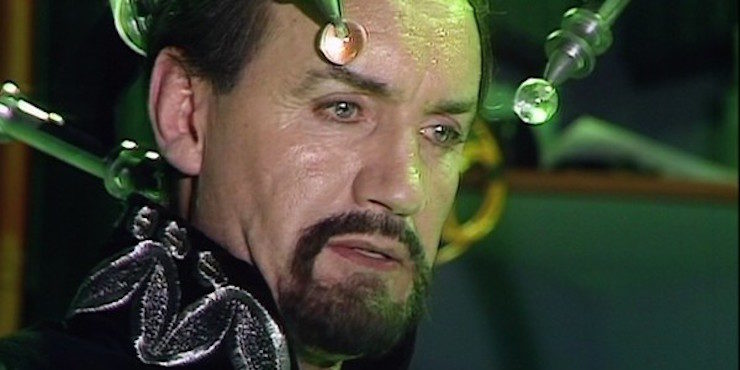
Ainley’s stint as the Master was where I first started watching Doctor Who, and he remains one of my favorite aspects of the show. He took the urbane, upper class approach Delgado brought to the role and added a mischievous, charming spin. Ainley’s Master is at the start of his lives and he LOVES his work, and that enthusiasm comes across every time he’s on screen. He’s joyous and feral in equal measure and clearly obsessed with the Doctor. Witness his excellent turn in “The Five Doctors”, where the Master finds himself allied with the Doctor’s first incarnation. There’s an almost Loki-like quality to the character, as he enjoys messing with his (currently) elderly rival but at the same time seems desperate for his respect and attention. Ainley’s run is full of moments like this, and it remains a highlight of the show’s run of more than five decades.
That being said, Ainley’s Master, just like the first incarnation of the show, had a bad end. “Survival” was a great story that was murdered in the edit and is only dragged back over the line by the sheer effort expended by Sylvester McCoy, Sophie Aldred, Lisa Bowerman, and, of course, Ainley. Despite the story’s problems, his final scenes have real power to them, precisely because you know they are final scenes. The Ainley version of the Master goes out hard…while the show itself followed him a few minutes later, and would only return to fully televised glory sixteen years later.
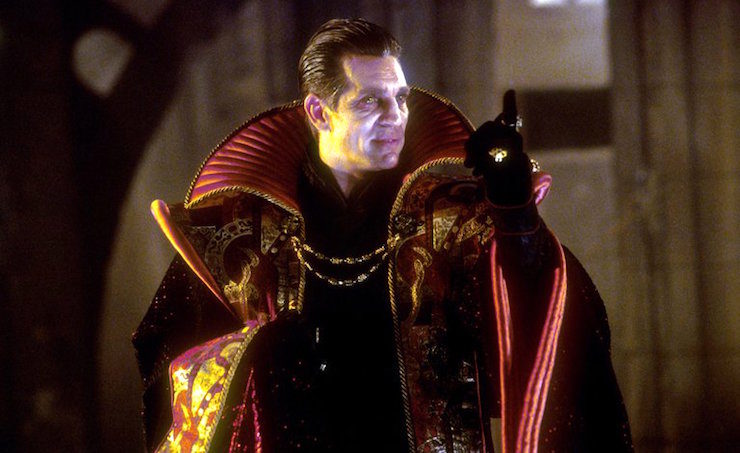
But let’s talk about Eric Roberts for a second. The 1995 TV movie gets a lot of flak, much of it richly deserved—however, the casting is spot on throughout and Roberts, in particular, is a joy. After the initial “zombie Terminator” scenes, which do fall a little flat, he rapidly transforms into one of the most entertaining incarnations of the character to date. Witty, urbane, just a little camp, and clearly tremendously enjoying the game, this Master is immensely relieved to still be alive and intent on having as much fun as possible. His verbal sparring match with the Doctor in the back of the ambulance is a joy, his relentless determination to survive is pure Master, and Roberts even wears the massive Gallifreyan robes well. Taken too soon, sir. Taken too soon.
That being said, if you absolutely have to leave the stage early, leave it early because Sir Derek Jacobi is up next. Jacobi technically only plays the Master for a handful of scenes. As Professor Yana, introduced in “Utopia” he comes across as far more as a Doctor analogue—there’s the same slightly flamboyant clothing, the same erratic charm. He even has a companion.
But it’s when Yana sees the pocket watch and finally starts to remember who he truly is that modern Doctor Who pulls off one of its greatest coups. In the space of a few seconds we see Jacobi prove exactly why he’s one of the best actors in the world. His posture, expression, everything changes as the memories come flooding back. Better still, with it comes one of the show’s most horrific, tragic, and understated realizations…
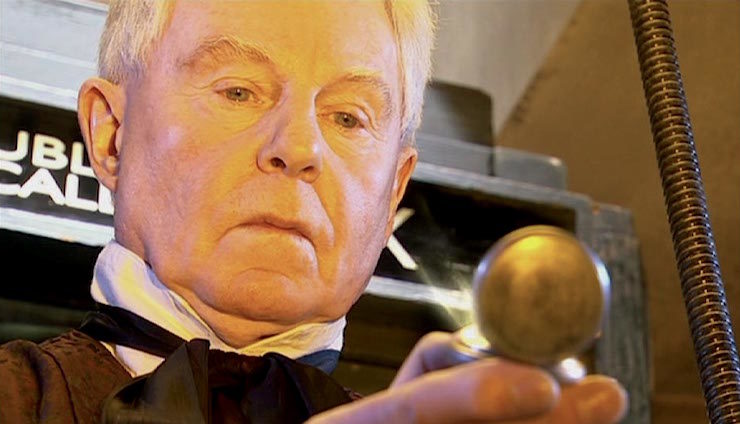
The Master, terrified by the events of the Time War, used a Chameleon Arch to hide himself away. And he hid inside the idea of the Doctor: a scientist, someone there to help, fixated on humanity, and unable to quite look his past in the eye. The Master’s disguise was the man he wanted to be but wasn’t brave enough to become. A man who, in turn, became far closer to the Master than he ever wanted to during his time as the War Doctor.
Jacobi’s work, and the writing underlying it, is extraordinary. It’s also the foundation for John Simm’s completely different but just as iconic portrayal. Show runner Russell T. Davies has often discussed how they’ve intentionally written Time Lords as imprinting on the people around them when they regenerate, taking on some of their qualities. This is why the second Tenth Doctor (let’s call him 10.5) sounds like Donna. It’s also a nice backhanded explanation for why Twelve is Scottish. His last thoughts as Eleven are of Amy Pond, so he carries her accent through into his next life.
In the Master’s case though, it leads to this delicious moment of self-awareness as one of the best actors of his generation basically does a frighteningly excellent impersonation of one of the other best actors of his generation. Simm’s Master is Tennant’s Doctor with the brakes off and too much caffeine: fast-talking, flamboyant, energetic, and delighting in the sound of his own voice. But where Ten has all these qualities tempered by his crippling survivors’ guilt and barely-contained rage, Simm’s Master has no such restrictions. Becoming Prime Minister, in what still stands as the show’s best-handled plot arc, is just the start.
Look at the moment that opens “Last of the Time Lords.” The Master’s exuberant song and dance number, set to “I Can’t Decide” by Scissor Sisters is a note-perfect sketch of everything you need to know about him. He’s joyously cruel, obsessed with order, can’t quite bring himself to kill the Doctor, and wants very badly for everybody to see how clever he is. That’s why Martha’s family are still alive and also why the most disturbing moment, I’d argue, in the entire modern run of the show to date, is hidden in plain sight.
Lucy Saxon’s black eye. Glimpsed in passing but categorically there, and unavoidable.
This version of the Master is abusive, the Doctor’s love for humanity curdled into something the Master can’t escape and can’t deal with. His offhand cruelty grounds his epic schemes in the most literal sense: this fraction of a man, this fraction of a Time Lord only knows violence and plausible charm. Everything he builds contains the means of his own destruction as a result and it’s no accident that Lucy is ultimately responsible for both his demise here and his maiming in “The End of Time.” By then, Simm’s Master is closer to the Beevers and Pratt version: a leaking container of feral energy whose plan is carried out as much to see if he can do it as for any practical or tactical reason.
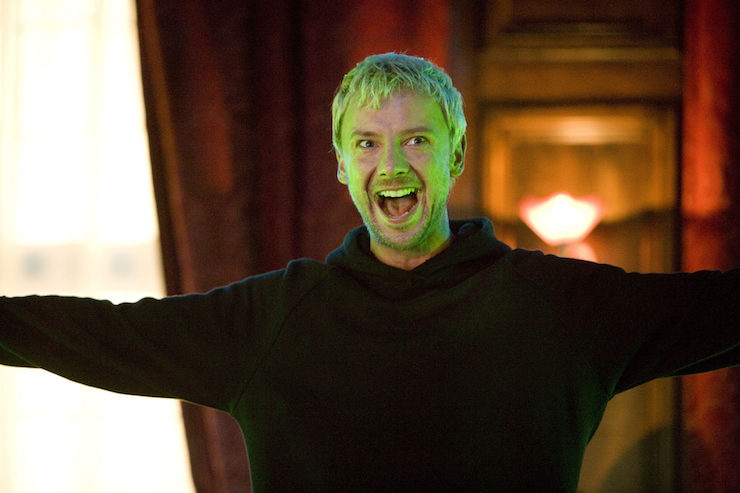
And yet, this Master also has arguably the best ending of any incarnation. The power dynamic between Tennant and Simm in that final episode is incredible, and they really emphasize the idea that these two men are only ever one bad or good day from being each other. The repeated “Get behind me” moment is particularly fantastic, as the Master closes the circuit on his own morality. He’s a monster. His people are monsters, and they’ve made him so. Finally, his violence and rage is pointed in the right direction and he does the one good thing he can do: save the world, even as he runs towards his first, and last, good fight.
Her fight, it turns out, was just beginning…
Missy, played by Michelle Gomez, may be the single best idea the new version of the show has ever come up with. Costumed like an evil Mary Poppins, Missy takes the feline curiosity and savagery of Simm’s incarnation to glorious new levels. She also tempers it with a level of patience no incarnation since the original has had and the result is just a joy. Missy is influencing the story long before we see her, bringing Clara and the Doctor together and manipulating events to keep them where she wants them. When she finally makes her presence felt it’s a moment of pure theater: the Doctor caught completely off-balance and wrong-footed not just by her presence but her plan.
More impressive still, the idea of Missy wanting to help the Doctor become someone new is sweet, even kind, albeit in a deeply disturbing way. Just as she’s become a woman for (we presume) the first time, the Doctor is now on a new set of lives. Everything’s up for grabs and the moment where she loses her patience and yells “I WANT MY FRIEND BACK!” is all the explanation we need. This is Missy trying to “save” the Doctor. It also hints as some very interesting—and very dark—implications about just what sort of young Time Lord the Doctor once was.
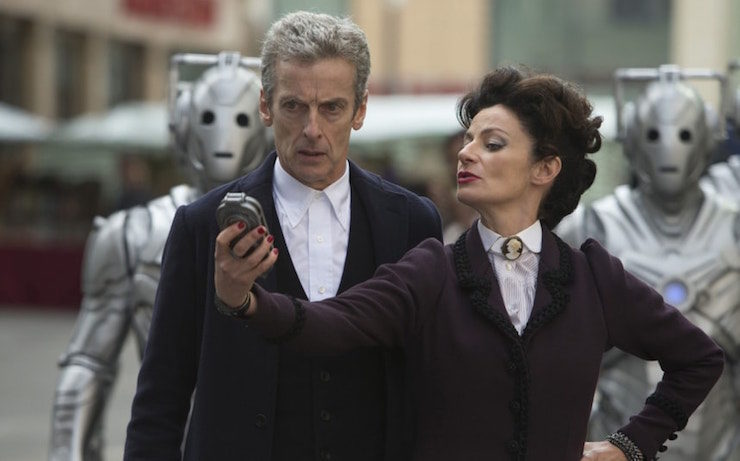
Plus, Missy is FUN in a way no previous version has been. Her double act with Clara in “The Witch’s Familiar” is some of the funniest material the show has ever produced and it’s all sold by Gomez’s fizzy, gleeful delivery. “Not seeing you as sandwiches now” and “Every miner needs a canary” are especially great lines, but every moment they’re on screen together is comedy gold. Better still, it’s all completely earned and in service to the script. Clara is an eminently fragile human on a planet full of angry robotic death machines. Missy is a force to be reckoned with, possessing an unknown number of extra lives and a galaxy-sized reservoir of self-belief—one who can quip, whilst murdering a Dalek, “I’m a Time Lady; it’s our golf.”
The Master is the definitive Doctor Who villain (now villainess). Like all the best nemeses, she’s a reflection of him, defined by the exact opposite of his choices and motivations. And like all truly extraordinary nemeses, she’s also absolutely at peace with that dynamic. That’s why I hope the Simm and Missy incarnations get along: because…well, they have a lot to talk about. Either way, the thought of seeing not one but two incarnations of one of the best villains in TV history on screen at the same time has us eagerly counting the hours until the show returns on Saturday.
Alasdair Stuart is a freelancer writer, RPG writer and podcaster. He owns Escape Artists, who publish the short fiction podcasts Escape Pod, Pseudopod, Podcastle, Cast of Wonders, and the magazine Mothership Zeta. He blogs enthusiastically about pop culture, cooking and exercise at Alasdairstuart.com, and tweets @AlasdairStuart










